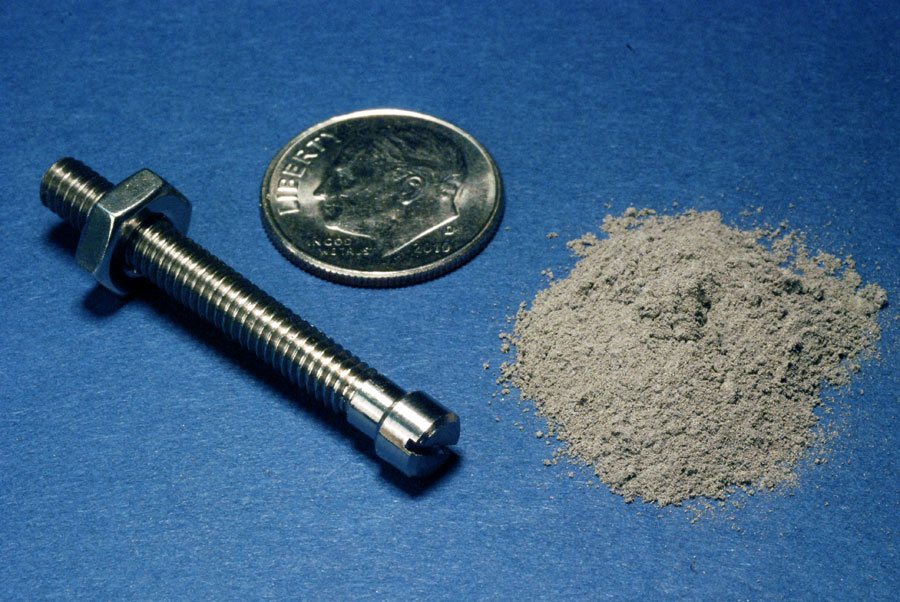The Ames Laboratory in Iowa has perfected a titanium powder suitable for use in additive manufacturing. The Ames Lab titanium metal powder has a smooth, regular texture and is ideal for laser sintering in powder bed fusion 3D printing, this product is superior to titanium powder produced using the traditional method of production, claims new research.

What is the Ames Lab?
The Ames Lab is one of 17 national laboratories overseen by the national Department of Energy (DOE). Oak Ridge National Laboratory (ORNL) in Tennessee, is another important site for 3D printing materials development in the additive manufacturing industry.
This research into gas atomization as a manufacturing method for spherical metal powders was funded by three different institutions:
- The Iowa State University Research Foundation – that gives funds to help the commercialization of research results.
- The State of Iowa Regents Innovation Fund – also seeking to help nurture the commercialization of research, but with a special interest in advanced manufacturing applications.
- The U.S. Army – who also conduct their own advanced manufacturing research at the Army Research Lab (ARL) in Maryland.

The Ames Lab titanium powder is distributed by Praxair, the third-largest industrial gas company in the world, who are based in Connecticut.
Praxair bought the material when it took over Ames Lab’s specialist Iowa Powder Atomization Technologies Inc. (IPAT), a company set up with for the purpose of commercializing Ames Lab metal powders.
Imperfections in melting and sintering metal powders
Production of spherical metal powder is not easy. Under the wrong conditions surface texture and size can be uneven or irregular, other flaws in the process can result in “satellites” or smaller particles bonded to the main sphere. When laser sintering an uneven metal powder, molecules of un-melted metal can be sucked into the melted path created by the laser. This is an area where substantial research efforts are concentrated, including work at NIST and California’s $6 billion Lawrence Livermore National Laboratory (LLNL).
These partially melted molecules then cause imperfections and structural weakness in a finished 3D metal part. Industrial manufacturers, such as Boeing, or GE, are keen to develop materials that eradicate this risk. Post production non-destructive testing is a critical, yet time-consuming, phase of additive manufacturing for 3D printed metal.
Emma White, one of the leading associate scientists of metallurgy at Ames, explains,
[Particles in a traditionally produced metal powder] don’t flow past each other, and that’s going to require a pulsing mechanism or an agitator in the manufacturing process. That’s going to cost the manufacturer more in energy to run their production line.
Ames Laboratory’s gas atomization method
There are around six different methods of atomization in use to make metal powders. All are based on the same structure where a liquid metal is introduced to a chamber conditioned with either gases, water or plasma torch beams.
Ames Lab’s method of powder production uses argon, nitrogen, or helium gases to break the liquid metal into spheres. Ames Lab’s range of materials, nickel, copper, iron, aluminium, titanium and more alloys suggest that the process is most likely the common method of gas atomization. However, the smooth spherical surface of the metal powders suggest that plasma may have been involved in the process, as applying plasma produces a denser, purer metal powder.
Slow motion clip showing gas atomisation of stainless steel. Clip from AmesLaboratory on YouTube in 2011.
Ames Lab’s gas atomization process has earned the institute 16 different patents, including Dispersoid reinforced alloy powder and method of making from 2012, and an In-situ control system for atomization from 1995.
Subscribe to our newsletter and follow us on social media to stay current with all the latest developments in 3D printed metal and news about additive manufacturing.
Featured image shows ‘A magnified image of a metal powder particle, produced by our laboratory’s high-pressure gas atomization technique. ‘ SEM image from: Ames Laboratory
Nominations for the 1st Annual 3D Printing Industry awards are now open


